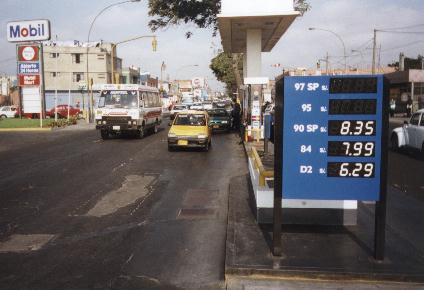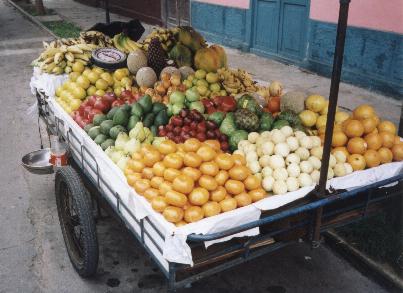South America
main page

Lima

Machu Picchu

Ecuador

Quito Prison

Back to kentfoster.com
I believe I have set a world record for longest voluntary stay in Lima, Peru (middleweight division): 5 days. Lima is universally regarded as a horrible city, a dreaded, inevitable transit point where the goal is to try to get in and out in the same day. To be sure, Lima inspires no poetry. ("Lima, O Lima, I prithee, Cast your foggy fumes o'er me"), but it is fun. Travelers seem paranoid about the crime, which is nothing to ignore, but compared to big Western cities it is overstated. Machu Picchu, Cuzco and Lake Titicaca can wait; give some time to Lima and you will be rewarded.
A primary reason Lima is unloved is that travelers can't accept that Lima is not as beautiful as the place they just came from, but take notice of things you don't see elsewhere. Marvel at the way pilots can land aircraft in the dense fog where they wouldn't even try in other countries. Marvel at how you will never see the sun through the fog, yet it is neither cold nor windy. Marvel at the armed security guards wearing bulletproof vests in a small, discount clothing store. Marvel at Peruvian radio's breadth of progressive musical styles. Marvel at the gas station outside the hostel that is literally in the middle of the road. 
There is plenty to see and do. (However, I wouldn't recommend going to the zoo. The animals are interesting enough, but the hordes of terrible school kids taunting the defenseless animals are too much. If you ever see a well-behaved kid in a zoo, adopt him.)
Lima is often the first place someone begins a South American trip because it's usually the cheapest flight destination, which is odd since Peru has no real international airline. The first experiences you have in a new city put you in the mood to be open to its joys and here, Lima is a challenge. The airport, for instance, can be foreboding. Emerging from immigration into the terminal can be a jolt to the system as you are confronted with a throng of people and then you are at the mercy of a noisy, gigantic, unfamiliar city.
But here is what you do:
After you get through immigration, literally push your way through the crowd that won't part, ignore the shady, official-looking people who are too eager to assist you, and walk past all the of the people offering taxis, which will be expensive if you get one from the airport parking lot. Walk out of the airport terminal, go to the left, and follow the others who walk along the sidewalk to the street. It's a short walk. Dozens of taxis sit on the street waiting for passengers to come to them. If you are worried about getting ripped off--or worse--by a taxi driver, pick one of the tiny, new Daewoo Tico taxis with a lighted "Taxi" sign on the roof (not much of a precaution, but somewhat safer than the common sticker-on-the-windshield type) and a driver who appears grandfatherly and just looking to eke out an honest living.
Tell him in your confident, been-here-a-million-times Spanish to take you to Bolivar and Brasil (streets) in (the district of) Pueblo Libre. I bargained down to 7 soles (3.5 soles=$1), which is probably not much more than a local would pay. Once you are at the large Santa Isabel supermarket, go about 4 blocks west and one block south to Marfil Guest House (address: Parque Ayacucho 126, tel 261-1206 or 463-3161). Of course, you could take a taxi straight there, but taxi drivers doubtfully would know the tiny Parque Ayacucho. The hostel is in the Lonely Planet book under its old name, Hostal de Las Palomas, I believe. It is the only hostel they mention in Pueblo Libre. The taxi ride is not far from the airport. You could take a colectivo bus, but the system takes some studying to understand. I recommend the colectivo only for the way back to the airport if you are up for it.
Pueblo Libre is just a regular neighborhood, but that is its attraction. This is the Lima you have unwittingly come for. Close by are supermarkets, cinemas, travel agents, outdoor markets and a few museums. The neighborhood is safe, pretty well lit, and central to many other parts of town.
I emailed Cosy at cosycollyor@yahoo.com and she sent a nice map plus made a reservation at the hostel for me that kept changing as my arrival date kept changing. She checks email regularly and can set you up in a room on the roof for $6. The place isn't the easiest to find the first time as there is no sign for the hostel. It is typical of a lot of places in Peru where the fašade is non-descript, but the appearance is deceiving because behind the doors Marfil is very homey and safe.
Marfil Guest House is a great place to have diarrhea and be stuck (cable TV, internet, lots of books, magazines, clean toilet with seat, free toilet paper, etc.) so by all means take the opportunity to try ceviche (raw fish marinated in lemon, onion and chile with onions, avocado, nuts, and corn-on-the-cob on the side) at the public market down the street. Peruvian ceviche is worth making the trip to Peru on its own. Actually, the best part of town to try it is on the main square of Barranco, where every Saturday afternoon they have a "Barranco Taste Festival". You can get excellent, hygienic, inexpensive food from top chefs in the little park area on the opposite side from the library. Hopefully it is still going on.
| 2009 update! I stayed here again. The Santa Isabel supermarket is now Plaza Vea. The local phone is 463-3161. 22 soles (US$7) for a room with common bathroom. |
Viva Los Colectivos!!
Getting to Barranco is easy with the colectivos. In fact, you can get a colectivo on Bolivar outside the hostel and go just about anywhere you want in Lima. The colectivo system is not as intimidating as it seems and must be embraced. People are very friendly and will help you get to where you want to go, remind you of your stop, and tell you to watch your stuff if troublemakers get on. No one tried to shortchange me either; Peruvians are stand-up people.
In most cities with colectivos the vehicles are minivans. In Lima it is unique because they use everything from small Japanese minivans to bigger 40 seaters to North American stubby school buses to giant regular school buses to giant foreign buses that were probably donated. No matter the bus, they are absolutely gutted out save for the bare minimum. Some of these old buses have enormous steering wheels dwarfing the driver. The dashboard is useless, just wires hanging everywhere. For some reason the gearbox is situated relative to the seat such that to throw it in second gear requires a wicked back motion like bringing a bowling ball behind you on the upswing. I also saw a few buses so decrepit and rusted that they were virtually in the process of disintegrating. Whole roof sections flapped in the wind and with any bump on the road.
By rights the bus drivers should be equipped with gas masks. Intense fumes seep up through the gaps in the motor casing and inhaling that all day long together with the exhaust from the other colectivos on the road is a double whammy. They would make for great case studies, too. Most are inexplicably serene with an inner calm. I have no idea how they achieve this Zen-like state. One drove by a church and did the cross thing with his hand on his chest without ever looking at the church. Another had the right idea by stuffing his ears with tissue. They love their horn so much, I wondered if they'd drive if their horns weren't working. I got the answer later when I saw a driver reach out the window and slap his door, and it was nearly as loud.
There are so many colectivos that they jockey hard for fares (usually one sol regardless of distance). Each colectivo has a guy who stands in the doorway and constantly yells its route and hawking for people to come aboard. They never cease chattering.
To see all these colectivos wave around each other, cutting each other off, speeding past, cutting off again, often in big old dilapidated wrecks of school buses, riding the horn--I love it. I love this big city experience. It's part of enjoying urban civilization, third world style. This enervates me while in a place like Lima.

(Fruit cart in Barranco, Lima)
When I was traveling around Peru I frequently found myself debating and defending Lima. People are too eager to pass through and not give it a chance. The same haste to judge applies to why it is rare to hear a kind word for renowned, despised places such as Jakarta, Indonesia or Guayaquil, Ecuador, but I can readily stick up for them as well. The point is to relax and accept it for what it is and what it can offer. It's also my innate belief that a big city by definition must offer something or else everyone wouldn't be drawn to it. In this case, 8 million Limenos can't be wrong!
And finally, the very pompous: This page © Copyright 2002, Kent Foster